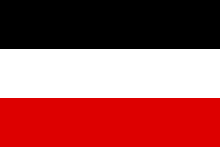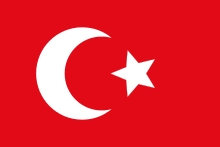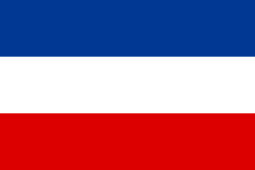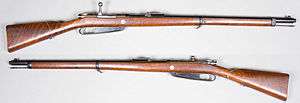Gewehr 1888

The Gewehr 88 (commonly called the Model 1888 commission rifle) was a late 19th-century German bolt action rifle, adopted in 1888.
The invention of smokeless powder in the late 19th century immediately rendered all of the large-bore black powder rifles then in use obsolete. To keep pace with the French (who had adopted smokeless powder "small bore" ammunition for their Lebel Model 1886 rifle) the Germans adopted the Gewehr 88 using its own new M/88 cartridge, which was also designed by the German Rifle Commission.[8] The rifle was one of many weapons in the arms race between the Germanic states and France, and with Europe in general. There were also two carbine versions, the Karabiner 88 for mounted troops and the Gewehr 91 for artillery. Later models provided for loading with stripper clips (Gewehr 88/05s and Gewehr 88/14s) and went on to serve in World War I to a limited degree. Unlike many German service rifles before and after, it was not developed by Mauser but the arms commission, and Mauser was one of the few major arms manufacturers in Germany that did not produce Gewehr 88s.[9]
Design
In 1886, fifteen years after their defeat by German forces in the Franco-Prussian War, the French Army introduced the new Lebel magazine rifle firing an 8 mm high-velocity projectile propelled by the new smokeless powder. This made Germany’s rifle, the Mauser Model 1871, obsolete due to its large and slow 11 mm round propelled by black powder. The practical result was that the French rifle had greater accuracy and range, giving French troops a tactical advantage over the German Army. In response the German Army’s Rifle Testing Commission developed the Gewehr 88 which was adopted for service in 1888. For this reason the Gewehr 88 is also known as the "commission rifle," or "reichsgewehr".
Cartridge

The first step was to design a new cartridge; the Patrone 88 or M/88. This began by adapting a Swiss design, resulting in a new 8 mm rimless "necked" cartridge (bullet diameter 8.08mm / .318 in) which featured single-base smokeless powder. In 1905, the 8 mm M/88 cartridge which was introduced in 1888 and loaded with an 8.08 mm (.318 in) 14.6 g (226 gr) round-nose bullet was replaced by the 7.92×57mm Mauser S Patrone (ball cartridge) which was loaded with a new 8.20 mm (.323 in) 9.9 g (154 gr) spitzer bullet and more powerful double-base smokeless powder. The United States military followed a similar chambering modernization process from the 30-03 to the 30-06 Springfield.
Receiver and magazine

The Gewehr 88 is in essence a Mannlicher design, though it is sometimes (incorrectly) called a "Model 88 Mauser". It has a receiver with a "split bridge" (i.e., the bolt passes through the receiver and locks in front of the rear bridge); a rotating bolt head; and the characteristic Mannlicher-style "packet loading" or "en-bloc" system in which cartridges are loaded into a steel carrier (a charger clip) which is inserted into the magazine, where it holds the cartridges in alignment over a spring. As shots are fired the clip remains in place until the last round is chambered, at which point it drops through a hole in the bottom of the rifle. This system was used in almost all Mannlicher designs and derivatives, and while it allows for speedy reloading, it also creates an entry point for dirt. To settle a patent infringement claim by Steyr-Mannlicher, Germany contracted the Austro-Hungarian company to be one of the manufacturers of Gewehr 88s.
Bolt and barrel
The commission rifle's bolt action design was a modified Mannlicher action with a few Mauser features, but it is not truly a "Mauser". The barrel design and rifling were virtually copied from the French Lebel. The rifle has an odd appearance as the entire barrel is encased in a sheet metal tube for protection, but with the tube removed the rifle looks rather modern. This tube was intended to increase accuracy by preventing the barrel from directly contacting the stock, but in practice it increased the risk of rusting by providing a space for water to be trapped if the rifle was exposed to harsh conditions. The Karabiner 88 utilized a different bolt handle, which resembled those found on commercial sporting rifles.
Service history
Some early models had flaws due to rushed ammunition production; anti-Semitic factions within the German press exploited these flaws, alleging a conspiracy between one of the rifle’s manufacturers, the Ludwig Loewe Company, and other Jewish-owned manufacturers, including the firm manufacturing the smokeless powder. Thus the rifle became known derisively as the Judenflinte ("Jews' musket"), despite the fact that appoximately three-quarters of the rifles were produced by factories not owned by Jews.[9]
Part of the production run was exported to China (see lower) or Latin America (for example Brazil army use them in War of Canudos in 1896–1897). The commission rifle saw field service with Germany's colonial expansion, including in China during the Boxer Rebellion (with the Gewehr 88s and the unlicensed Hanyang 88 copies also being used by the opposing Chinese troops), and served as a front line weapon for German troops during World War I until 1915 when the supply of Gewehr 98s increased. When Germany replaced the 88 with the Gewehr 98, many of the rifles were given to Austria-Hungary and the Ottoman Empire during World War I because both states had a shortage of rifles (however, it was used extensively by the Turkish Army even through the 1930s and 1940s). Many Gewehr 88 rifles stayed in active service in second-line units, reserves, and in armies allied with the Germans through and well past World War I.
Most of the Gewehr 88s seen in the US are the ones that were given to the Turkish forces in World War I and have been modified from the original design. The Turks issued these and updated versions at least as late as the 1930s. Gewehr 88/05 rifles were also used by Yugoslavia,[10] Czechoslovakia, (for example as modified guard shotgun)[11] or Poland. Gewehr 88 rifles have been used widely during post World War I revolutions, uprisings and wars (usually on both sides of the Russian Civil War, the German Revolution of 1918–19, the Revolutions and interventions in Hungary (1918–20), the Greater Poland Uprising (1918–19), the Silesian Uprisings, the Turkish War of Independence, the Polish–Soviet War,[12] by the Ulster Volunteers, the Ulster Special Constabulary and also on the other side during the Irish War of Independence and by Lithuanians in the Lithuanian Wars of Independence). About 5,500 Gewehr and Karabiner 88s were delivered to the Lithuanian Army in 1919-1920 (granted by Germany and sold by France and the UK). Used by the paramilitary Rifle Union, the rest were kept in the storage and were re-barreled before World War II. Inter-war Germany used Gewehr 88 rifles only for the militia. Gewehr 88 rifles were also used in the Spanish Civil War by both sides.[13] At the beginning of World War II some Gewehr 88 rifles were still in use, by second line units or paramilitary organizations (or partisans) in Poland[14] and Yugoslavia.[15] Part of the ex-UVF rifles are used by Home Guard in United Kingdom in 1940.[16] Ethiopean rifles (some ex-UVF rifles also found their way there) also saw action during the East African Campaign. These rifles were also used by the German Volkssturm in 1944–1945.[17]

China also used this rifle extensively during the Qing dynasty and the Republican era. China first bought Gewehr 88 rifles for the First Sino-Japanese War in 1894–1895 and after that started production of the unlicensed Hanyang 88 copy. In the beginning of the 20th century China bought for a second time a large number of original Gewehr 88 rifles. In following nearly 50 years it and its Hanyang 88 copy were used in the Xinhai Revolution, the Chinese Civil War and the War of Resistance against Japan and proved more than adequate against the Japanese Arisaka Type 38 rifle, though the latter was newer by 30 years. The last time they saw action in Chinese service was during the Korean War, where some of them were captured and taken to the US as souvenirs.[18]
The rifle was adopted during a period of rapid development in firearms technology, and marked Germany's shift to a smokeless powder. This explains why its period as the primary German service rifle was just over a dozen years, but it remained in limited service for much longer. In 1898 a Mauser design was adopted, the Gewehr 98, which was the culmination of a series of Mauser models in the 1890s. It was a superior replacement using the same ammunition with a stronger powder charge. However, this rifle soon had to be converted to fire the new pointed round that Germany adapted after the turn of the century. With these modifications the newer design remained in use until the end of World War II.
The Gewehr 88 was also sometimes made into very elegant sporting rifles by gunsmiths in Germany. Examples of these usually show first-class workmanship and special features such as folding sights and altered bolt handles. Some Karabiner 88 carbines are known to have been produced in 7×57mm Mauser instead of the usual M/88 or the 7.92×57mm Mauser chambering.[19] These were likely intended for sale in South America, where use of the 7×57mm cartridge was widespread, but no military adopted it in this caliber. All known 7×57mm Karabiner 88s were produced by Haenel.
Variants
At the time of adoption, the M/88 "Patrone 7.9 mm" was loaded with a 14.6 g (226 gr) round nose bullet that measured 8.08 mm (.318 in) in diameter. In 1894/95 the German Army changed the barrel specifications from 7.9/8.1 mm to 7.9/8.2 mm hoping to improve accuracy and Gewehr 88 rifles made from that date on had different bores. The 8.08 mm (.318 in) bullet diameter however remained unchanged. After 1895 most Gewehr 1888 rifles were regrooved. In 1905, the Germany Army adopted a new service cartridge that fired lighter bullets measuring 8.20 mm (.323 in) in diameter. From then on, many Gewehr 88 rifles were rechambered to fire the new 1905 pattern 7.92×57mm Mauser cartridge becoming Gewehr 88/05 rifles.[8] This rechambering required more work as the 7.92×57mm Mauser chambering required a wider chamber throat to take the thicker brass of the new 1905 pattern cartridge. Gewehr 88/05 adapted rifles have the receiver marked with a large "S" rollmark and were also converted to use the Gewehr 98 type stripper clip by adding stripper clip guides to the top rear of the receiver and altering the magazine.
Modern ammunition use
The maximum operating pressure for the Gewehr 88 commission rifle is less than that of any 8 mm Mauser rifle, as the makers of the Gewehr 88 did not fully understand the greater energy of smokeless powder compared to black powder. Shooters planning to use modern 8 mm ammunition in a Gewehr 88 slug their bore and chamber as there are four different possible bores and grooves and chamber dimensioning combinations found on the Gewehr 88 rifle. High performance and hence high pressure or military ammunition designated for machine gun use cannot be fired safely in a Gewehr 88 commission rifle.
Defects
Although the packet loading system proved to be a design shortcoming, it is not uncommon to encounter a Gewehr 88 today which still retains it. Some of them were modified to use the stripper clips used with the Gewehr 98 by milling a slot into the left side of the action and adding stripper clip guides on the top of the receiver. Through this slot projects a bar which retains the cartridges in place against the magazine spring's pressure. The hole in the bottom of the rifle is often covered with a small piece of sheet metal.
Unlike many rifles designed later, the bolt head of this rifle is able to be removed from the bolt body. This piece could be removed during disassembly, and was frequently lost. Additionally, both the ejector and the extractor that are attached to the bolt head are prone to falling out if care is not taken during disassembly and reassembly.
Users
.svg.png) Austria-Hungary[20]
Austria-Hungary[20] Brazil[21]
Brazil[21] Kingdom of Bulgaria[22]
Kingdom of Bulgaria[22] Czechoslovakia
Czechoslovakia Ecuador
Ecuador.svg.png) Ethiopian Empire
Ethiopian Empire German Empire[23]
German Empire[23].svg.png) Nazi Germany: Used by Volkssturm
Nazi Germany: Used by Volkssturm.svg.png) Kingdom of Greece[24]
Kingdom of Greece[24] Irish Republic[16][25]
Irish Republic[16][25] Orange Free State[26]
Orange Free State[26] Ottoman Empire[27]
Ottoman Empire[27] Peru[28]
Peru[28] Second Polish Republic[14][29]
Second Polish Republic[14][29].svg.png) Qing Dynasty[30]
Qing Dynasty[30] Republic of China[30]
Republic of China[30] People's Republic of China
People's Republic of China Russian Empire
Russian Empire.svg.png) Soviet Russia
Soviet Russia South African Republic[26]
South African Republic[26] Republic of Lithuania About 5500 rifles and carbines in 1919–1940.
Republic of Lithuania About 5500 rifles and carbines in 1919–1940. Turkey
Turkey Kingdom of Yugoslavia
Kingdom of Yugoslavia United Kingdom: Used by Home Guard
United Kingdom: Used by Home Guard Ulster Volunteers[31]
Ulster Volunteers[31]
Gallery
 Infanteriegewehr Model 1888
Infanteriegewehr Model 1888 Cutaway model of the Gewehr 88
Cutaway model of the Gewehr 88 Schematic. Images #5 and #6
Schematic. Images #5 and #6 Cartridges M88
Cartridges M88
See also
References
- ↑ "Fuzil da Comissão Alemã de 1888 "Gewehr '88" (Rev. 1b)". Armas On-Line.
- ↑ http://www.wildlife-baldus.com/download/Maji_Maji.pdf
- ↑ http://www.fhhljx.com/thefreelibrary/Russian+rifles+of+the+great+war,+revolution+%26+civil+war--part+I%3A...-a0391733875
- ↑ "Weapons Of The Greco-Turkish War Part 2".
- ↑ "Three members of the Ethiopian Zabagna, or gendarmerie, photographed about the time of the Italian invasion in the fall of 1935 [721 x 807] : HistoryPorn". reddit.
- ↑ "República – Armas – Infantería – Fusiles".
- ↑ "The Official NJGF Photo Thread!". New Jersey Gun Forums.
- 1 2 8×57mm IS cartridge portrait – Totgesagte leben länger, Wild und Hund 11/2006 (German)
- 1 2 http://www.texastradingpost.com/m88/commission88.html
- ↑ "Rifles of Yugoslavia and Serbia".
- ↑ "VHU PRAHA".
- ↑ "Broń strzelecka polskiego wojska w wojnie polsko-bolszewickiej".
- ↑ http://www.amigosmuseovalencia.es/pdf/bol06c.pdf
- 1 2 "Karabin i karabinek Mannlicher-Mauser wz.1888". dobroni.pl.
- ↑ "Fremden Gerät".
- 1 2 "Firearms of the Irish Civil Wars: Part 2 the Republicans: their Unionist opponents had a much better quantity and variety of arms, but the Republicans put theirs to a lot more use.".
- ↑ "Kennblätter fremden Geräts".
- ↑ "1888 Commissioned Rifle Project".
- ↑ http://www.texastradingpost.com/m88/7mmcarbine.html
- ↑ "M1913 Mannlicher Gew88 Austro Hungarian Rifle".
- ↑ "brazilpage".
- ↑ "Standard Catalog of Military Firearms".
- ↑ "ACTUAL ARTICLE TITLE BELONGS HERE!". oldrifles.com.
- ↑ "Weapons Of The Greco-Turkish War Part 1".
- ↑ "Le G88 Kommission Gewehr". tircollection.com.
- 1 2 R. Bester, Boer Rifles and Carbines of the Anglo-Boer War, War Museum of the Boer Republics, Bloemfontein, 1994 (See also Wessels 2000, p. 80).
- ↑ Garander. "Turk Mauser – Gew. 88".
- ↑ https://www.riflemagazine.com/magazine/PDF/ri142partial.pdf
- ↑ "Zbrojownia tamtych lat – Arsenał odrodzonej armii".
- 1 2 "ACTUAL ARTICLE TITLE BELONGS HERE!". oldrifles.com.
- ↑ "Weapons of the Irish Revolution – part I 1914–16". The Irish Story.
External links
| Wikimedia Commons has media related to Gewehr 1888. |
